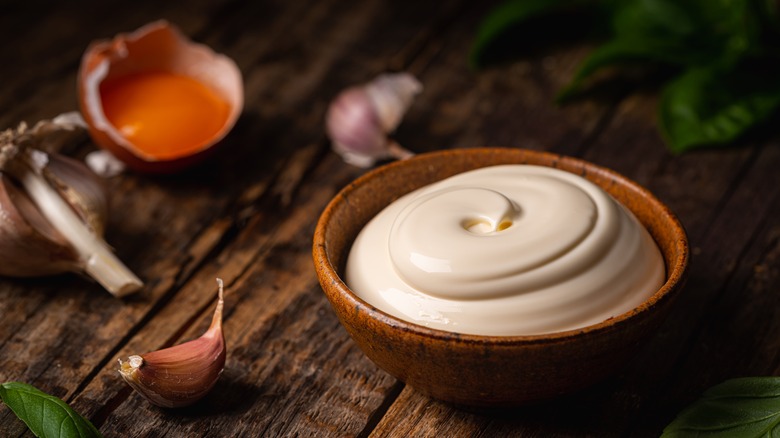The Time Mayo Was Considered A Luxury Food
If you somehow run out of things to argue about around the dinner table, bring up the topic of condiments. Start with ketchup, and sit back as your friends and family defend the tomato product's place — or, if you ask some people, lack thereof — on hot dogs. Then, once your party is all riled up over the virtues of yellow mustard versus Dijon, it will be your duty as the chaos puppet master to ring in the grand finale: mayonnaise. You'll likely find that creamy white dressing incites the most passionate responses of all, both positive and negative.
Many of us were introduced to mayo by way of its popular store-bought brand, Hellmann's, which touts itself as the world's #1 mayo. Meanwhile, for some, their love of the condiment didn't blossom until they tried a family mayonnaise recipe that comprised the basic combination of oil, egg yolks, lemon juice, and Dijon, plus a "secret ingredient" like tarragon or love. Homemade or not, the versatile, familiar condiment doesn't exactly scream "luxury." With this in mind, it may surprise you that the food's origins are steeped in it.
A French victory sauce
You know that feeling when you win a battle and you don't have the right ingredients to make a creamy sauce to celebrate, so you make one up with the provisions at hand? France's Duke de Richelieu allegedly found himself in this situation, and some people believe it led to the creation of mayonnaise. The tale goes back to 1756, during the Seven Years' War, as relayed in Slate. The story goes that Richelieu "lacked the cream he needed for a righteous victory sauce" and settled for a dressing made of eggs and oil instead, which he called "mahonnaise" after Port Mahon in Spain, where he and his forces had laid siege. According to The Record, Hellmann's endorses the story.
As Slate tells it, though, that theory was contested by a Frenchman who believed that the sauce originated in the French city of Bayonne (apparently a more elite culinary location) and was therefore originally called "bayonnaise." The debates raged on, primarily between French and Spanish food historians, for years. Regardless of which mayonnaise creation story you believe, though, it's widely accepted that France put the condiment on the map; Slate notes that the name of the sauce started appearing in French-inspired cookbooks around the 19th century.
The Industrial Revolution shifted mayo's reputation
According to Food Republic, American mayonnaise as we know it didn't come into the picture until the Industrial era, when companies began selling it en masse. Before that, Slate says that the upscale New York restaurant Delmonico's used it in its "chicken mayonnaise" and "mayonnaise of lobster" dishes in 1838, and other fancy establishments used it for Waldorf salad. Back then, the only people who kept jars of mayonnaise in their layman's kitchens were those with a yen for haute cuisine.
Mayo's current, more accessible reputation owes itself to Hellmann's, which got its start in a far less expensive New York eatery: Hellmann's Delicatessen. According to the company's website, the first jars of the stuff hit the scene in 1920 and were "filled to the brim with a delicious blend of ingredients picked to create the ultimate creamy texture and taste." Five years later, the brand slapped its signature blue ribbon on the labels, which apparently sparked quite the demand. Now, mayonnaise is just as comfortable in a Waldorf salad as it is on a slapdash ham sandwich.


